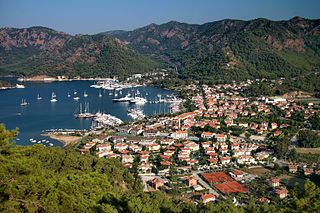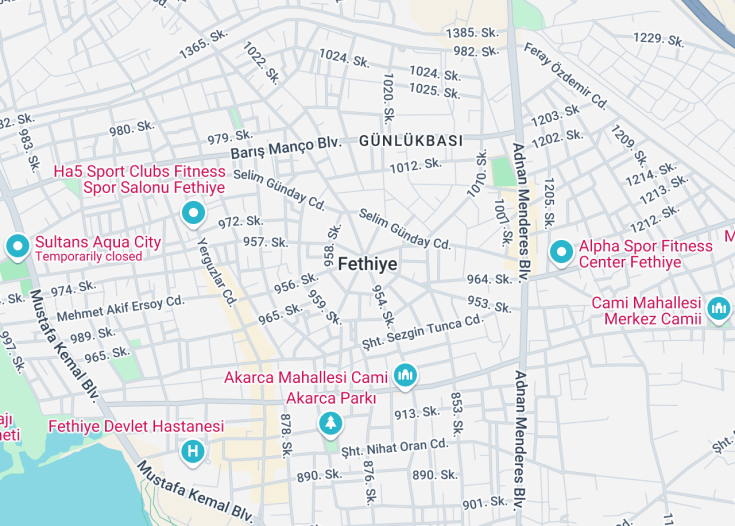Fethiye, a charming town nestled on the turquoise coast of Turkey, offers a rich tapestry of history, stunning natural landscapes, and vibrant cultural heritage. Known for its ancient ruins, including the renowned Lycian rock tombs, and pristine beaches such as Ölüdeniz, Fethiye attracts history enthusiasts and nature lovers alike.
The town also serves as a gateway to the picturesque Butterfly Valley and offers myriad opportunities for sailing and paragliding, making it a perfect destination for adventure seekers.
Plan your visit during spring or early autumn to enjoy comfortable weather while avoiding the peak tourist seasons, ensuring a more relaxed exploration of Fethiye’s treasures.
Don’t miss a boat trip to explore the nearby islands and secluded bays; it’s an ideal way to experience the serene beauty and crystal-clear waters of Fethiye’s surroundings.
Top things to do & see in Fethiye
Select the following sights and activities to discover best tickets and tours available in Fethiye.
Fethiye: A Lush Riviera Gem
| Country | Turkey |
| Time in Fethiye | GMT+3 |
| Language spoken | Turkish |
| Population | 161,000 (Data from City Population Review) |
| Currency | Turkish Lira (TRY ₺) |
| Airports |
|
Fethiye, a charming district of Muğla Province in Turkey, boasts a picturesque setting along the coastline of the Turquoise Riviera. Rich in history, the area is scattered with remnants from the ancient city of Telmessos, showcasing Lycian rock tombs, Roman amphitheatres, and Byzantine fortresses. The natural harbor of Fethiye opens up to an archipelago of stunning islands and coves, making it a prized destination for yacht tourism.
Moreover, Fethiye’s unique blend of natural and historical attractions includes the Saklıkent Canyon and the serene butterfly valley, making it not only a haven for sun-seekers but also for history buffs and adventure lovers. The bustling market, selling a range of traditional Turkish crafts and local foods, invites tourists to experience Turkish culture and cuisine firsthand. Equally appealing are the region’s traditional villages, where time seems to stand still, and its luxurious seafront resorts that cater to every whim of holidaymakers.
Where is Fethiye?
Located in southwestern Turkey, Fethiye is nestled on the edge of the Aegean Sea with direct access to the Mediterranean.
Distances:
| Route | Distance by car | Time by car |
|---|---|---|
| Istanbul to Fethiye | 500 miles | Approx. 8 hours |
| Ankara to Fethiye | 380 miles | Approx. 6 hours |
| Izmir to Fethiye | 150 miles | Approx. 3 hours |
| Antalya to Fethiye | 125 miles | Approx. 2 hours 30 min |
What is Fethiye famous for?
Fethiye is renowned for its rich historical legacy, captivating natural beauty, and as a leading sailing destination, featuring a pristine coastline and numerous secluded islands perfect for exploration.
History
Prehistoric and Ancient Times: Before 3000 BC – 334 BC
The region around Fethiye, known historically as Telmessos, shows signs of settlement extending back to the late Bronze Age. Early inhabitants were likely influenced by the flourishing cultures of the Aegean civilizations, and Telmessos became an important city in the ancient world, known for its skilled soothsayers who were descendants of the water nymph Manto. This period was marked by extensive trade and cultural exchange, which shaped the early development of the area.
Hellenistic Period: 334 BC – 30 BC
With the arrival of Alexander the Great in 334 BC, Telmessos and the surrounding region underwent significant Hellenization. The city was absorbed into the Seleucid Empire post-Alexander’s reign, further integrating Greek cultural and architectural influences. The era was characterized by the construction of monumental buildings and structures, many of which contributed to the city’s reputation as a center of art and learning.
Roman and Byzantine Periods: 30 BC – 1453 AD
The region was annexed by the Roman Empire in 30 BC and continued to thrive under Roman rule. The city became known as Fethiye in Byzantine times, named after a prominent Turkmen prince. The Byzantine era saw the construction of several Christian artifacts and buildings, transitioning from its pagan past. Despite frequent pirate attacks, Fethiye remained an important commercial and cultural center until the decline of the Byzantine Empire.
Ottoman Era: 1453 – 1918
Fethiye was incorporated into the Ottoman Empire following its conquest by the Turks. This period marked significant demographic changes with the introduction of Turkish administration and culture. The city was modernized with the construction of mosques, baths, and markets, which played a crucial role in its urban development. In 1856, it was struck by an earthquake that led to extensive rebuilding, providing Fethiye with a new architectural character reflective of the Ottoman period.
Modern Period: 1918 – Present
In the earlier part of the 20th century, Fethiye underwent tumultuous changes during and after World War I, including population exchanges between Greece and Turkey. Modern-day Fethiye has transformed into a charming tourist destination known for its natural beauty, historical sites, and vibrant culture. It has preserved many historical structures while integrating contemporary amenities and services that cater to international and local visitors alike, making it a unique blend of the old and the new.
Visit Fethiye
What to see and do in Fethiye
Exploring Fethiye provides a delightful mix of natural and historical attractions. Highlights include:
- The Tomb of Amyntas: A striking Lycian rock tomb carved into a cliff face around 350 BC.
- Saklıkent Gorge: A spectacular natural canyon ideal for hiking and refreshing dips in the mountain waters.
- Ölüdeniz Beach: Known for its turquoise blue sea and paragliding opportunities, offering breathtaking aerial views of the coastal landscapes.
- Fethiye Museum: Showcasing artifacts from the region’s intricate history across different civilizations, including Roman and Lycian relics.
- Kayaköy: Visit this nearby ghost town, abandoned after the population exchange between Turkey and Greece in 1923, for a poignant glimpse into the past.
Festivals and Events in Fethiye
Fethiye is vibrant with cultural festivities throughout the year. Notably, the Fethiye Culture and Arts Festival held in May provides a week filled with music, dance, and local crafts. The Air Games Festival in October gathers paragliding enthusiasts from around the globe, transforming the skies into a colorful spectacle above Ölüdeniz.
Best time to visit Fethiye
The ideal time to visit Fethiye is between April and June or from September to October. During these periods, the weather is pleasantly warm, perfect for exploring the outdoors and less crowded than the peak summer months.
Is Fethiye worth visiting?
Fethiye is absolutely worth visiting. Its unique blend of stunning natural landscapes, rich historical heritage, and vibrant cultural scenes make it a standout destination.
Whether you are looking to explore ancient ruins, enjoy beautiful beaches, or partake in lively cultural festivals, Fethiye offers a memorable experience for every type of traveler.










